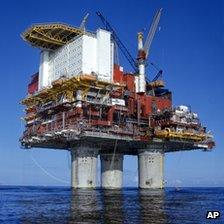Scottish independence: Oiling the referendum wheels
- Published

The advice casts light on when an independent Scotland would be able to contribute to an oil fund
The prospect of a Norwegian-sized oil fund is a powerful way of making the case for Scottish independence.
That's why it's playing a prominent role in the independence referendum campaign.
The Scottish government asked economists on the Fiscal Commission working party to draw up plans for an oil fund.
They came back with a recommendation for two; one for stabilising budgets when tax revenue can be volatile, and the other to use for longer term investments, as the Norwegians have done.
It's hard to argue with that. The UK Treasury has used oil and gas tax revenues for public spending, or to keep taxes lower than they would otherwise have been.
1980s surpluses
So when you contrast that with the £470bn in the Norwegian oil fund, it looks like an oil fund would have been a rather wiser way to handle the windfall and save something for the benefit of future generations.
By the reckoning of Scottish government economists, if Scotland had been independent with control of oil and gas revenues, if it had used that to pay off debt and build up a fund, and if its politicians and people had been willing to forgo the opportunities to spend it on keeping older industries from closing, then Scotland could have used the big surpluses of the 1980s to pay off debt by 1983, and could now be sitting on an oil fund worth between £82bn and £117bn, depending how successful the fund managers were in squeezing return out of it.
That's a useful illustration for the pro-independence campaign of an opportunity lost.
But that's not what the current argument is about. The question is when an independent Scottish government could start paying funds into an oil fund.
And we've now got internal advice from government economists which casts a rather different light on the possibilities from the one highlighted by Scottish ministers when they published the Fiscal Commission findings last week.
Future generations
Last week's report makes the case for the two new funds, and what they could achieve. The private advice behind it puts a lot more emphasis on the difficulty of finding any cash to put in it.

Norway has been tucking away some of the revenue raised from its oil industry
The thinking goes like this: after the big surpluses of the 1980s, a much lower oil price meant that Scotland had only one year in government budget surplus after 1990. That was in 2000-01, before Gordon Brown, as Chancellor, turned the spending taps on.
So while in deficit, the internal economic advisers emphasise that an oil fund would require an independent Scottish government either to raise taxes, or lower spending, or to borrow more, or a combination of those.
And they also emphasise that the reality of politics is that there's a lot more pressure to spend money on immediate demands than there is pressure to save for future generations.
As I found out when I went to Oslo to report on the fund, the Norwegian oil fund represents a national collective act of will to sacrifice now, and an act of faith that future generations will use the trust fund well.
That's not typical of the political discourse in Scotland or in the UK.
Private advice
What changed with last week's paper from the Scottish government was the claim that an oil fund could be built up while an independent Scotland continues to run deficits.
It's worth looking at the conditions under which that could happen. First, it would require the deficit to come down to a lower level than the long-term growth rate. Long term growth is below 3%, while the deficit is around 5%.
It would require debt to be falling. That's not going to happen until at least 2017 according to official projections. And even then, it would require adoption of George Osborne's austerity plans. And even once it's started, there's a colossal debt to pay off.
You would then have to be clear that the cost of borrowing is lower than the return on investment within the fund.
If you could be sure of that, then everyone would borrow money to do so. Indeed, that was the basis on which many people, pre-2008, borrowed heavily to pile into the property market, and you'll recall that it was with that expectation the banks encouraged them to do so.
Borrow to invest
The private advice to ministers last year looked at the cost of borrowing on ten-year UK Treasury bonds over 2000 to 2011, which ran to an average 4.4%.
It then looked at the return on investments made by Norway's oil fund. These have been very volatile, but averaged 4.1% over the same period. On that basis, you would lose money by borrowing to invest.
But by last week, the Fiscal Commission had found a different set of figures (page 61, footnote 87). In the past five years, it showed the cost of Treasury borrowing has been very much lower, at 3.3% (much of that time with interest rates at historic lows).
Returns on Norway's investment over those five years ran to a rather healthier 5.9%.
It's on that basis that we're told there's a "compelling case" to build up an oil fund while running a deficit.
It's also a compelling case for being sceptical about figures deployed in such arguments.
In this case, taking a ten-year period produces the evidence for one side of the argument. Choosing to use only five years of data provides a conclusion that helps the other.
And neither a ten- nor five-year time horizon looking to the past can tell you what's going to happen in the future.
- Published10 October 2013
